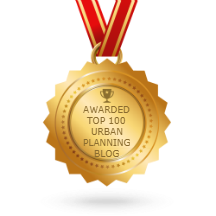Transit oriented development station typology revisited
The Washington Post ("Welcome to the loneliest Metro stop ") discusses how the Loudoun Gateway Metrorail station is pretty desolate. There's a decent discussion on Reddit about it. The main issue is the station is exurban compared to the core of the region and that much of the Silver Line is more like a commuter railroad than a subway line--ridership on the Silver Line is pretty pathetic, when all is said and done. It reminds me of the UMN Center for Transportation Studies study of the Hiawatha Light Rail Line there, which found that the best ROI is within the first 10 miles of the system. From the article:
But at Loudoun Gateway, the second-to-last stop on the Silver Line extension, there is never any bustle. This year, an average of 317 people have entered the Loudoun station each day, according to Metro’s rail ridership survey. That’s about 0.08 percent of the system’s daily riders.
What's frustrating to me is the failure to recognize there is a station typology that makes it easier to understand why stations can be successful with TOD and others are much less likely to be so. You'd think after almost 50 years of experience with Metrorail, this would be better understood.
And it's not like Metrorail hasn't already created a station typology, although it was focused more on bicycle and pedestrian access, it's applicable to TOD questions.
I wrote a summary piece about this a few years ago, "The ability to develop around transit stations is conditional on land use and mobility context" (2021). From the entry:
Categorizing transit stations in terms of access (and indirectly, the opportunity for development. Perhaps the best way to think about the opportunity for "transit oriented development" is to consider how WMATA categorizes its Metrorail stations, as laid out in the Bicycle and Pedestrian Access Improvements Study (2010), in Appendix D. There are nine categories, based on land use context, from dense/connected/compact to undense/disconnected.
- High Density Urban Mixed-Use in a Grid Network (21 stations)
- Urban/Suburban Residential Center -- (12 stations) [opportunity for multiunit buildings close to the station, even if the area is otherwise single family residential)
- Urban Residential Area with a Bus/Automobile Orientation (5 stations)
- Campus and Institutional (3 stations)
- Mixed use in a "pod" layout (13 stations) [isolated, disconnected locations]
- Long-Term Potential for High Density Transit Oriented Development (TOD) or Planned Unit Development (PUD) (4 stations)
- Suburban Residential Area (9 stations)
- Auto Collector/Suburban Freeway -- (5 stations)
- Employment Center/Downtown/Urban Core -- (12 stations)
- Smaller Town Center (Suburban/Exurban)
- Exurban Station (Residential primarily)
- High Density Urban/Suburban* Mixed-Use in a Grid Network (21 stations)
- Urban/Suburban Residential Center -- (12 stations) [opportunity for multiunit buildings close to the station, even if the area is otherwise single family residential)
- Urban Residential Area with a Bus/Automobile Orientation (5 stations)
- Campus and Institutional (3 stations)
- Mixed use in a "pod" layout (13 stations) [isolated, disconnected locations]
- Long-Term Potential for High Density Transit Oriented Development (TOD) or Planned Unit Development (PUD) (4 stations)
- Suburban Residential Area (9 stations)
- Auto Collector/Suburban Freeway -- (5 stations)
- Employment Center/Downtown/Urban Core -- (12 stations)
- Smaller Town Center (Suburban/Exurban)
- Exurban Station (Residential primarily)
- Exurban Station (light industrial)
Labels: Growth Machine, station area planning, transit and economic development, transit oriented development, transportation planning



2 Comments:
Letter to the editor about the Silver Line and Loudon Gateway station
https://www.washingtonpost.com/opinions/2025/01/10/silver-line-purple-line-telework/
A regret in retrospect
The Dec. 28 Metro article “Welcome to the loneliest Metro station” discussed the pitiful ridership and lack of development at the Loudoun Gateway Silver Line station but did not give a full story of how this came about. I served on the Loudoun County Board of Supervisors in July 2012 when we voted 5-4 to have the county opt in to build the Silver Line and join the Metro compact.
As The Post alluded to, the station was one of several envisioned by a 1990s-era plan to build a mixed-use development similar to Crystal City at the Route 606 stop. But the commercial market went south and there was considerable opposition from the Metropolitan Washington Airports Authority (MWAA) to any residential development at the station — which sits on MWAA land — for fear of airport noise complaints. Loudoun County eventually revised its comprehensive plan to allow for some residential development on the periphery, but the owners of those properties didn’t submit development proposals for the county planners to review. One of them sold the land for data centers, as did the MWAA, which sold its “Western Lands” at the Loudoun Gateway station to a data company for almost $237 million.
Data centers also are popping up near the Ashburn station at the terminus of the line at Route 772 and the Dulles Greenway. But at least the builder, Comstock, put skin in the game by building mixed-use developments even before the station opened in 2022.
When we voted in favor of the Silver Line, my colleagues and I on the board believed that or the MWAA and the other two property owners, Eric Wells and Chris Antigone, were going to deliver on employment-related commercial development. But they didn’t, in large part because the data centers are willing to pay top dollar for property near power stations and one of the nation’s key nodes for the World Wide Web.
The MWAA got the best of the Silver Line deal: a rail line to the airport paid for by toll payers and taxpayers of Fairfax and Loudoun counties. (Thankfully, this burden fell mostly on commercial landowners and not on many individual residents.) The MWAA has no responsibility to pay an annual subsidy to Metro. And the MWAA did not have to get involved in the expensive and uncertain process of getting mixed-use development approved. Data centers, until recently, could be approved with minimal government oversight.
The special tax district the board implemented in late 2012 in Ashburn and Sterling, primarily encompassing commercial and industrial properties, is able to pay Loudoun’s Metro capital costs. And the regional gas tax is paying the Metro subsidy without passing those costs along to the county’s homeowners and renters via higher property taxes, though that funding formula might not balance out forever.
But if I had to vote again, I would have moved to cancel or delay the Loudoun Gateway station altogether and save some $300 million on the project, as well as the expense of a big, empty parking garage.
Ken Reid, Tysons
The writer is a former member of the Loudoun County Board of Supervisors.
https://www.loudoun.gov/2639/Dulles-Rail-Service-Districts
Dulles Rail Service Districts
Board Adopts Metrorail Service Districts
The Loudoun County Board of Supervisors adopted Metrorail Service Districts, designed to fund the Metrorail Silver Line extension to Loudoun County. The service districts, which are located in the areas surrounding the three planned Loudoun County Metro stations, are designed to help pay for the construction of the Silver Line to this area of the county and for the ongoing costs of providing the Metrorail service at those stations. An additional real property tax may be levied in the districts for these purposes, at a maximum rate of $0.20 per $100 of assessed property value.
Maryland wants to encourage development around transit stations
https://www.thebanner.com/politics-power/state-government/maryland-transit-development-study-FORTQ3XZZRAZBMG7MABECMLK5A/
State to study development opportunities along Baltimore’s Light Rail and Metro SubwayLink, as well as along the MARC Penn Line
The state wants to take a comprehensive look at opportunities for what’s known as transit-oriented development, which typically involves building housing, shops and offices around transit hubs. The state believes that well-thought-out projects can benefit both communities and commuters and wants to cultivate the most viable ideas.
“We have a tremendous opportunity for the state to play a more active role that maybe we haven’t played historically in the past,” Wiedefeld said.
Post a Comment
<< Home